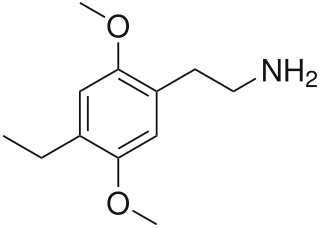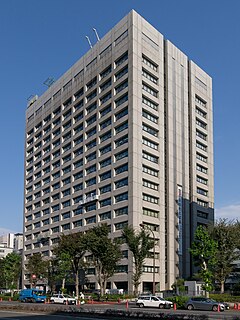
2C-E is a psychedelic phenethylamine of the 2C family. It was first synthesized by Alexander Shulgin.

2C-C is a psychedelic drug of the 2C family. It was first synthesized by Alexander Shulgin, sometimes used as an entheogen. In his book PiHKAL , Shulgin lists the dosage range as 20–40 mg. 2C-C is usually taken orally, but may also be insufflated. 2C-C is schedule I of section 202(c) of the Controlled Substances Act in the United States, signed into law as of July, 2012 under the Food and Drug Administration Safety and Innovation Act.

The National Police Agency is an agency administered by the National Public Safety Commission of the Cabinet Office of the Cabinet of Japan, and is the central agency of the Japanese police system, and the central coordinating agency of law enforcement in situations of national emergency in Japan.

The Ministry of Defense is a cabinet-level ministry of the Government of Japan charged with preserving the peace and independence of Japan and maintaining national security with the Japan Self-Defense Forces.
Law of the People's Republic of China, officially referred to as the Socialist legal system with Chinese characteristics, is the legal regime of China, with the separate legal traditions and systems of Mainland China, Hong Kong, and Macau.
The Dangerous Substances Directive was one of the main European Union laws concerning chemical safety, until its full replacement by the new regulation CLP Regulation (2008), starting in 2016. It was made under Article 100 of the Treaty of Rome. By agreement, it is also applicable in the EEA, and compliance with the directive will ensure compliance with the relevant Swiss laws. The Directive ceased to be in force on 31 May 2015 and was repealed by Regulation (EC) No 1272/2008 of the European Parliament and of the Council of 16 December 2008 on classification, labelling and packaging of substances and mixtures, amending and repealing Directives 67/548/EEC and 1999/45/EC, and amending Regulation (EC) No 1907/2006.

The Canadian Environmental Protection Act, 1999 (CEPA 1999) is an Act of the Parliament of Canada, whose goal is to contribute to sustainable development through pollution prevention and to protect the environment, human life and health from the risks associated with toxic substances. It covers a diversity of activities that can affect human health and the environment, and acts to address any pollution issues not covered by other federal laws. As such, the Act is a "catch all" piece of legislation that ensures potentially toxic substances are not inadvertently exempt from federal oversight as a result of unforeseen legislative loopholes.

The Emergency Planning and Community Right-to-Know Act of 1986 is a United States federal law passed by the 99th United States Congress located at Title 42, Chapter 116 of the U.S. Code, concerned with emergency response preparedness.
Eugenics has influenced political, public health and social movements in Japan since the late 19th and early 20th century. Originally brought to Japan through the United States, through Mendelian inheritance by way of German influences, and French Lamarkian eugenic written studies of the late 19th and early 20th centuries. Eugenics as a science was hotly debated at the beginning of the 20th, in Jinsei-Der Mensch, the first eugenics journal in the Empire. As the Japanese sought to close ranks with the West, this practice was adopted wholesale, along with colonialism and its justifications.
Capital punishment is a legal penalty in Taiwan. The death penalty can be imposed for murder, treason, drug trafficking, terrorism and especially serious cases of robbery, rape and kidnapping and many other serious offenses, such as piracy and also for military offences, such as desertion.
Wasei-kango refers to words in the Japanese language composed of Chinese morphemes but invented in Japan rather than borrowed from China. Such terms are generally written using kanji and read according to the on'yomi pronunciations of the characters. While many words belong to the shared Sino-Japanese vocabulary, some kango do not exist in Chinese while others have a substantially different meaning from Chinese; however some words have been borrowed back to Chinese.
Title 40 is a part of the United States Code of Federal Regulations. Title 40 arranges mainly environmental regulations that were promulgated by the US Environmental Protection Agency (EPA), based on the provisions of United States laws. Parts of the regulation may be updated annually on July 1.
The J-BIS Biounit is an immigration control system that was introduced into Japanese airports. It is a machine that is located at the immigration booth. When a person who wishes to enter the country and applies for disembarkation, fingerprints of both index fingers are collected along with a photograph. At the same time, the person is checked against immigration office lists, and criminals, people who were previously deported, and other punished foreigners are prevented from entering the country. On November 20, 2007, Narita Airport, Kansai International Airport, and Chūbu Centrair International Airport had the system, with plans to roll out the system to the 27 airports and 126 harbors in the country.

Wildlife Protection Areas in Japan are established by the Ministry of the Environment and, for areas of more local importance, by the Prefectural Governments in order "to protect and promote the reproduction of birds and mammals" in accordance with the 2002 Wildlife Protection and Hunting Law (鳥獣の保護及び狩猟の適正化に関する法律). The areas established have a maximum duration of twenty years and hunting is prohibited within them. Special Protection Areas (特別保護地区) are designated within the Wildlife Protection Areas in order to protect habitats and ecosystems.

The Businesses Affecting Public Morals Regulation Law (風俗営業等の規制及び業務の適正化等に関する法律), also known as 風俗営業取締法 or fueiho, is a law that regulates entertainment places in Japan.
Adire Legal Professional Corporation is a Japanese law firm.
Kawamoto Kōmin was a 19th-century Japanese scholar of Rangaku and also a doctor. His true name was Yutaka (裕), art name Yuken (裕軒). His father was Kawamoto Shuan, a clan doctor of Sanda Domain. Today he is known as a "father of chemistry in Japan" thanks to his works.
The Cannabis Control Law (大麻取締法) of Japan, aka 1948 Law No. 124, is the national law of Japan concerning cannabis possession, cultivation, and transfer.










